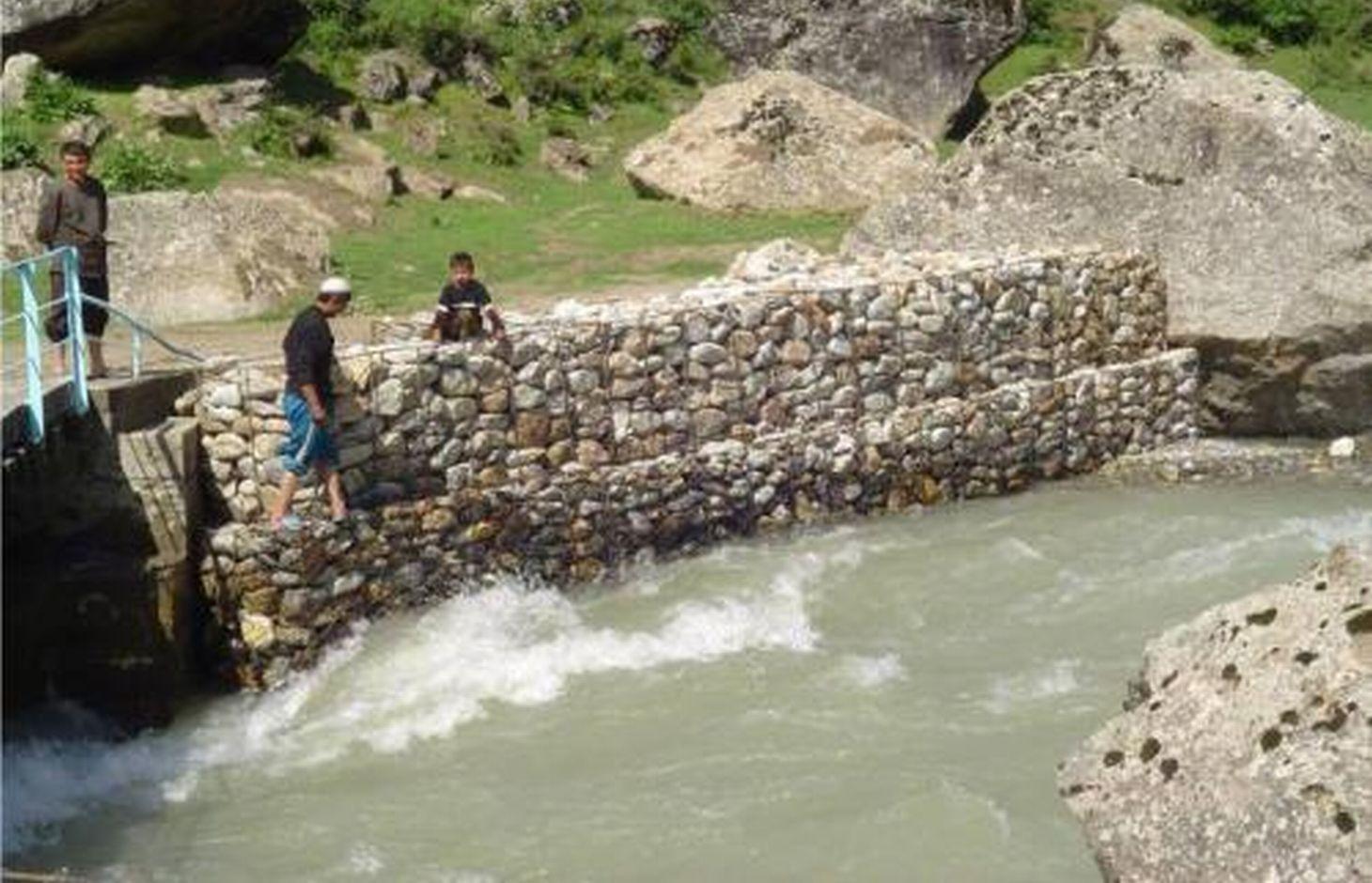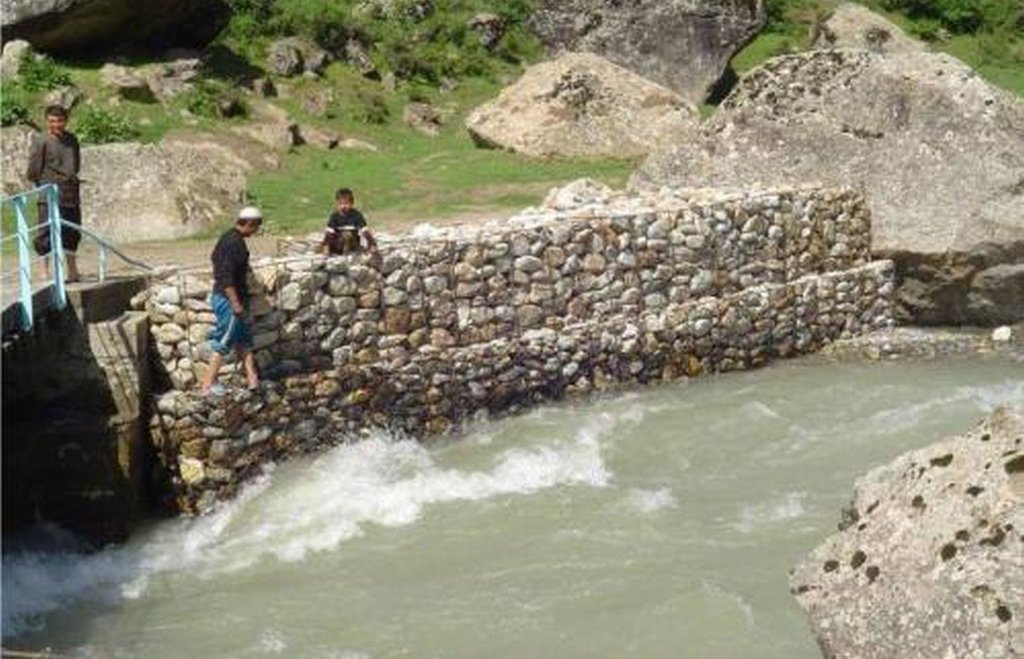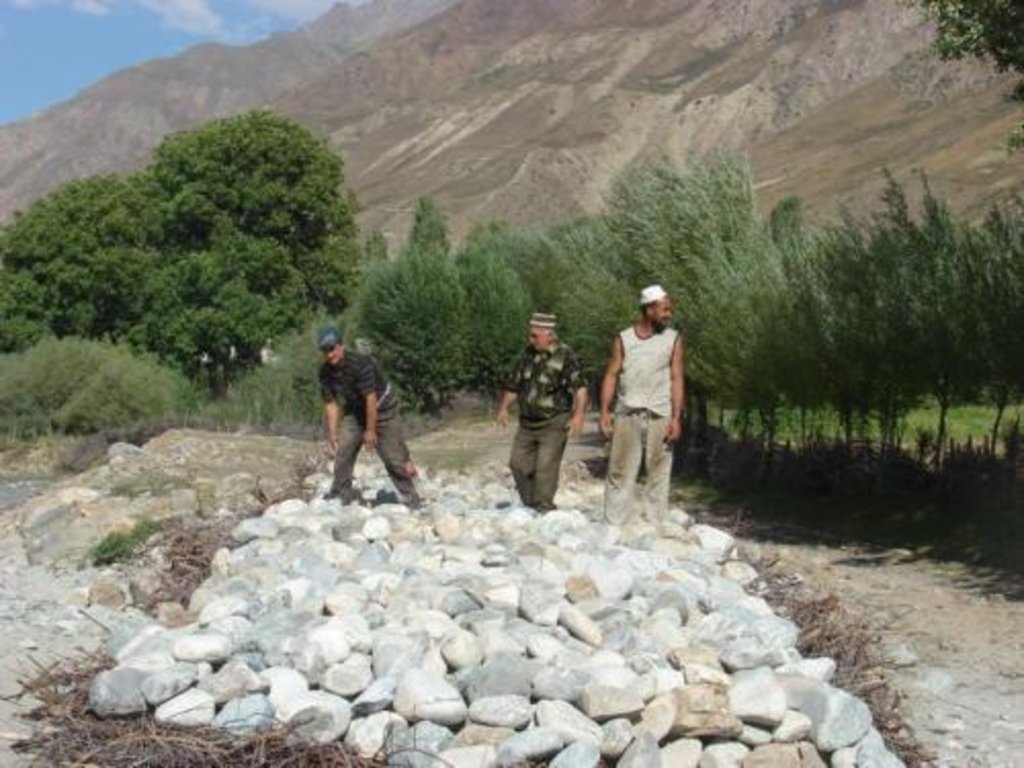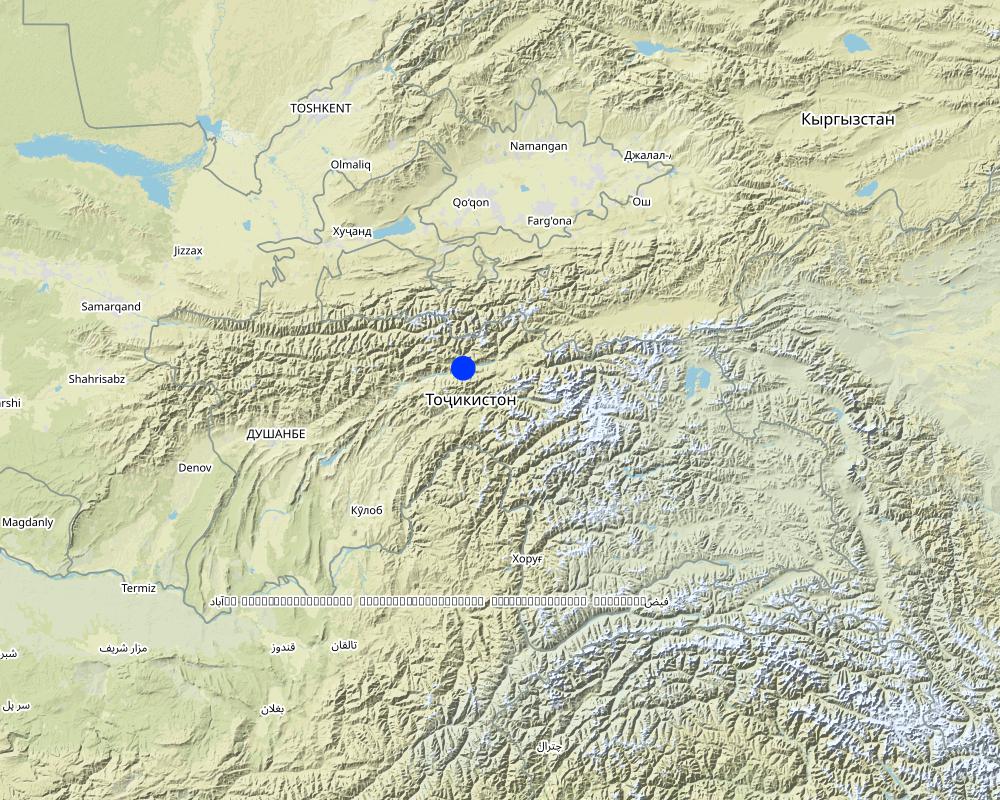Укрепление берегов рек с помощью камней и габионов [Tajikistan]
- Creation:
- Update:
- Compiler: German Kust
- Editor: –
- Reviewers: Olga Andreeva, Joana Eichenberger
Strengthening of the river banks with stones and gabions (English)
technologies_1362 - Tajikistan
- Full summary as PDF
- Full summary as PDF for print
- Full summary in the browser
- Full summary (unformatted)
- Укрепление берегов рек с помощью камней и габионов: Maart 21, 2017 (inactive)
- Укрепление берегов рек с помощью камней и габионов: Julie 31, 2017 (inactive)
- Укрепление берегов рек с помощью камней и габионов: Feb. 14, 2020 (inactive)
- Укрепление берегов рек с помощью камней и габионов: Nov. 2, 2021 (public)
View sections
Expand all Collapse all1. General information
1.2 Contact details of resource persons and institutions involved in the assessment and documentation of the Technology
SLM specialist:
Rakhimov Rustam
Community Agriculture and Watershed Management project in Tajikistan
Tajikistan
Name of project which facilitated the documentation/ evaluation of the Technology (if relevant)
Community Agriculture and Watershed Management project in Tajikistan (WB / CAWMP)Name of project which facilitated the documentation/ evaluation of the Technology (if relevant)
Pilot Program for Climate Resilience, Tajikistan (WB / PPCR)1.3 Conditions regarding the use of data documented through WOCAT
The compiler and key resource person(s) accept the conditions regarding the use of data documented through WOCAT:
Ja
1.4 Declaration on sustainability of the described Technology
Is the Technology described here problematic with regard to land degradation, so that it cannot be declared a sustainable land management technology?
Nee
2. Description of the SLM Technology
2.1 Short description of the Technology
Definition of the Technology:
Укрепление берегов рек и противоселевые мероприятия с помощью камней и габионов
2.2 Detailed description of the Technology
Description:
Технология заключается в сборе камней , в основном среднего размера (20-40 см в диаметре) и укладке их особым способом в местах, подверженных наиболее сильному воздействия течения реки и размыванию для предотвращения от дальнейшего размывания земель, занятых поселениями или сельскохозяйственными полями. Традиционно применяется два типа укладки камней: (1) в виде габионов, то есть вертикальных стен из камней, скрепленных проволокой, (2) в виде каменной кладки на матах из ветвей деревьев и кустарников.
Назначение технологии: Предотвращение размыва берегов речными и селевыми потоками
Основные действия и вложения: сбор камней\ветвей деревьев, их укладка особым способом, скрепление камней ветвями или проволокой
Природная\социальная обстановка: берега рек \ сельские поселения
2.3 Photos of the Technology
2.5 Country/ region/ locations where the Technology has been applied and which are covered by this assessment
Country:
Tajikistan
Region/ State/ Province:
Таджикистан
Further specification of location:
Таджикабадский район, джамоаты Ширинчашма и Шогадоев
Specify the spread of the Technology:
- evenly spread over an area
If precise area is not known, indicate approximate area covered:
- 1-10 km2
Is/are the technology site(s) located in a permanently protected area?
Nee
Comments:
Всего выполнено 6 подпроектов по берегоукреплению в рамках проекта Всемирного Банка CAWMP. В данном описании приводятся данные в основном для Таджикабадского района
Map
×2.6 Date of implementation
If precise year is not known, indicate approximate date:
- more than 50 years ago (traditional)
2.7 Introduction of the Technology
Specify how the Technology was introduced:
- as part of a traditional system (> 50 years)
3. Classification of the SLM Technology
3.1 Main purpose(s) of the Technology
- reduce, prevent, restore land degradation
- protect a watershed/ downstream areas – in combination with other Technologies
- reduce risk of disasters
3.2 Current land use type(s) where the Technology is applied
Land use mixed within the same land unit:
Ja
Specify mixed land use (crops/ grazing/ trees):
- Silvo-pastoralism

Cropland
- Annual cropping
Number of growing seasons per year:
- 1
Is intercropping practiced?
Nee

Grazing land
Extensive grazing:
- Ranching
Animal type:
- sheep

Forest/ woodlands
- (Semi-)natural forests/ woodlands
Comments:
Основные проблемы землепользования (по мнению составителя): размывание берегов речными и селевыми потоками, уменьшение полезной площади земель
Основные проблемы землепользования (по мнению землепользователя): размывание берегов речными и селевыми потоками, уменьшение полезной площади земель
Смешанное: (eg агро-пастбище, лесо-пастбище): да
Землепользование после внедрения УЗП технологии: Другое: Os: строения, инфраструктурная сеть
Скот пасется на остатках сельскохозяйственных культур
Ограничения для поселений: риск сноса части территории
3.3 Has land use changed due to the implementation of the Technology?

Grazing land

Settlements, infrastructure
Comments:
Другое: Os: строения, инфраструктурная сеть
3.4 Water supply
Water supply for the land on which the Technology is applied:
- mixed rainfed-irrigated
Comments:
Водопотребление: смешанное богарно-орошаемое
3.5 SLM group to which the Technology belongs
- cross-slope measure
- surface water management (spring, river, lakes, sea)
3.6 SLM measures comprising the Technology

vegetative measures
- V1: Tree and shrub cover

structural measures
- S5: Dams, pans, ponds
- S6: Walls, barriers, palisades, fences

management measures
- M3: Layout according to natural and human environment
Comments:
Основные мероприятия: инженерные
Второстепенные мероприятия: управленческие; связанные с использованием растительности
3.7 Main types of land degradation addressed by the Technology

soil erosion by water
- Wm: mass movements/ landslides
- Wr: riverbank erosion
Comments:
Основные типы деградации: Вр (Wr): эрозия берегов реки
Основные причины деградации: сильные / чрезмерные дожди (интенсивность/количество), наводнение
Второстепенные причины деградации: чрезмерное использование растительного покрова для бытовых целей, другие природные причины (лавина, извержение вулкана, сели, высоко уязвимые природные ресурсы, экстремальная топография и т.д., сели)
3.8 Prevention, reduction, or restoration of land degradation
Specify the goal of the Technology with regard to land degradation:
- prevent land degradation
Comments:
Основная цель: предупреждение деградации земель
Второстепенные цели: реабилитация / восстановление голых земель, предотвращение / сокращение деградации
4. Technical specifications, implementation activities, inputs, and costs
4.1 Technical drawing of the Technology
Technical specifications (related to technical drawing):
Необходимые технические навыки для работников: средний (должен иметь инженерное образование (гидротехническое))
Необходимые технические навыки для землепользователей: средний (должен иметь успешный опыт создания такого рода сооружений)
Основные технические функции: стабилизация почвы (например, с помощью корней деревьев против оползней)
Вторичные технические функции: контроль над концентрированными стоками: запруда / замедление, контроль над концентрированными стоками: дрена / отводка
Выравнивание: -линейное
Растительный материал: Д: деревья / кустарники
В блоках
Растительный материал: Д: деревья / кустарники
Деревья/ кустарники: деревья и кустарники высаживаются после установления габионов
Стена барьер
Высота насыпи/берегов/другое (м): 1-3
Ширина насыпи/берегов/другое (м): 0,5-5
Длина насыпи/берегов/другое (м): 5-20
Строительный материал (земля): при создании каменной кладки на матах из веток землей и наносами постепенно забиваются маты
Строительный материал (камень): основной материал, противостоящий водным и селевым потокам
Строительный материал (древесина): ветки деревьев используются для создания матов и скрепления камней
Строительный материал (другое): металлическая проволока используется для скрепления камней
Растительный используется для стабилизации структур
Изменение практик / уровня интенсивности землепользования: опасные ранее земли введены в использование
Изменение планировки, относящиеся к естественной среде и поселениям: сбережение участков земель, ранее опасных для поселения и сельского хозяйства
4.3 Establishment activities
| Activity | Timing (season) | |
|---|---|---|
| 1. | сбор черенков | Весна |
| 2. | черенки тополя или ивы и облепихи | Весна |
| 3. | посадка черенков | Весна |
| 4. | сбор и транспортировка камней | Весна-Лето-Осень |
| 5. | сбор и транспортировка веток деревьев | Весна-Лето-Осень |
| 6. | укладка растительных матов и\или камней | Весна-Лето-Осень |
| 7. | скрепление камней в габионах | Весна-Лето-Осень |
| 8. | Проектирование сооружения | в течение года |
| 9. | Организация работ | в течение года |
4.5 Maintenance/ recurrent activities
| Activity | Timing/ frequency | |
|---|---|---|
| 1. | замена разрушенных участков камней и крепления | Весна-Лето-Осень |
| 2. | посадка черенков | Весна |
| 3. | Контроль состояния сооружений | в течение года |
| 4. | Ремонтные мероприятия | в течение года |
4.6 Costs and inputs needed for maintenance/ recurrent activities (per year)
Comments:
Затраты в размере 200-800 долларов США рассчитаны на 1 погонный метр среднестатистического сооружения при полностью ручном труде
4.7 Most important factors affecting the costs
Describe the most determinate factors affecting the costs:
время года, дальность транспортировки камней, высота сооружения, ширина толщина сооружения, возможность механизации работ
5. Natural and human environment
5.1 Climate
Annual rainfall
- < 250 mm
- 251-500 mm
- 501-750 mm
- 751-1,000 mm
- 1,001-1,500 mm
- 1,501-2,000 mm
- 2,001-3,000 mm
- 3,001-4,000 mm
- > 4,000 mm
Agro-climatic zone
- sub-humid
- semi-arid
Климат умеренный
5.2 Topography
Slopes on average:
- flat (0-2%)
- gentle (3-5%)
- moderate (6-10%)
- rolling (11-15%)
- hilly (16-30%)
- steep (31-60%)
- very steep (>60%)
Landforms:
- plateau/plains
- ridges
- mountain slopes
- hill slopes
- footslopes
- valley floors
Altitudinal zone:
- 0-100 m a.s.l.
- 101-500 m a.s.l.
- 501-1,000 m a.s.l.
- 1,001-1,500 m a.s.l.
- 1,501-2,000 m a.s.l.
- 2,001-2,500 m a.s.l.
- 2,501-3,000 m a.s.l.
- 3,001-4,000 m a.s.l.
- > 4,000 m a.s.l.
5.3 Soils
Soil depth on average:
- very shallow (0-20 cm)
- shallow (21-50 cm)
- moderately deep (51-80 cm)
- deep (81-120 cm)
- very deep (> 120 cm)
Soil texture (topsoil):
- coarse/ light (sandy)
Soil texture (> 20 cm below surface):
- medium (loamy, silty)
Topsoil organic matter:
- low (<1%)
5.4 Water availability and quality
Ground water table:
5-50 m
Availability of surface water:
excess
Water quality (untreated):
good drinking water
Water quality refers to:
surface water
Is water salinity a problem?
Nee
Is flooding of the area occurring?
Ja
Regularity:
episodically
5.5 Biodiversity
Species diversity:
- medium
Habitat diversity:
- medium
5.6 Characteristics of land users applying the Technology
Sedentary or nomadic:
- Sedentary
Market orientation of production system:
- mixed (subsistence/ commercial)
Off-farm income:
- > 50% of all income
Relative level of wealth:
- poor
Individuals or groups:
- groups/ community
Level of mechanization:
- manual work
- mechanized/ motorized
Gender:
- women
- men
Age of land users:
- youth
- middle-aged
- elderly
Indicate other relevant characteristics of the land users:
Землепользователи, применяющие данную технологию, в основном среднестатистические
Плотность населения: 50-100 человек/км2
Годовой прирост населения: 2% - 3%
5.7 Average area of land used by land users applying the Technology
- < 0.5 ha
- 0.5-1 ha
- 1-2 ha
- 2-5 ha
- 5-15 ha
- 15-50 ha
- 50-100 ha
- 100-500 ha
- 500-1,000 ha
- 1,000-10,000 ha
- > 10,000 ha
Is this considered small-, medium- or large-scale (referring to local context)?
- small-scale
Comments:
Средняя площадь земли, принадлежащая или арендуемая землепользователями для применения технологии: < 0.5 га, 0.5-1 га, 1-2 га
5.8 Land ownership, land use rights, and water use rights
Land ownership:
- communal/ village
- individual, titled
Land use rights:
- communal (organized)
- individual
5.9 Access to services and infrastructure
health:
- poor
- moderate
- good
education:
- poor
- moderate
- good
technical assistance:
- poor
- moderate
- good
employment (e.g. off-farm):
- poor
- moderate
- good
markets:
- poor
- moderate
- good
energy:
- poor
- moderate
- good
roads and transport:
- poor
- moderate
- good
drinking water and sanitation:
- poor
- moderate
- good
financial services:
- poor
- moderate
- good
6. Impacts and concluding statements
6.1 On-site impacts the Technology has shown
Socio-economic impacts
Production
production area
Income and costs
workload
Socio-cultural impacts
food security/ self-sufficiency
community institutions
conflict mitigation
Ecological impacts
Soil
soil loss
Climate and disaster risk reduction
flood impacts
6.2 Off-site impacts the Technology has shown
damage on neighbours' fields
6.3 Exposure and sensitivity of the Technology to gradual climate change and climate-related extremes/ disasters (as perceived by land users)
Gradual climate change
Gradual climate change
| Season | increase or decrease | How does the Technology cope with it? | |
|---|---|---|---|
| annual temperature | increase | well |
Climate-related extremes (disasters)
Meteorological disasters
| How does the Technology cope with it? | |
|---|---|
| local rainstorm | moderately |
| local windstorm | well |
Climatological disasters
| How does the Technology cope with it? | |
|---|---|
| drought | well |
Hydrological disasters
| How does the Technology cope with it? | |
|---|---|
| general (river) flood | not well |
Other climate-related consequences
Other climate-related consequences
| How does the Technology cope with it? | |
|---|---|
| reduced growing period | well |
6.4 Cost-benefit analysis
How do the benefits compare with the establishment costs (from land users’ perspective)?
Short-term returns:
positive
Long-term returns:
positive
How do the benefits compare with the maintenance/ recurrent costs (from land users' perspective)?
Long-term returns:
positive
Comments:
Экономическую пользу трудно оценить, поскольку предотвращенные риски могут быть очень затратными по восстановительным мероприятиям при критических ситуациях
6.5 Adoption of the Technology
- > 50%
Of all those who have adopted the Technology, how many did so spontaneously, i.e. without receiving any material incentives/ payments?
- 0-10%
Comments:
100% семей землепользователей применяют эту технологию с дополнительной материальной поддержкой
76 семей землепользователей применяют эту технологию с дополнительной материальной поддержкой
Пояснение в отношении к материальной поддержки: указано количество семей, применивших эту технологию в рамках проекта CAWMP
Существует тенденция к добровольному внедрению технологии
Комментарий к существующей тенденции: эти технологии традиционны в Таджикистане, но высокозатратны, поэтому нужны стимулирующие средства на ее применение
6.7 Strengths/ advantages/ opportunities of the Technology
| Strengths/ advantages/ opportunities in the land user’s view |
|---|
| снижение опасность критических ситуаций |
| Strengths/ advantages/ opportunities in the compiler’s or other key resource person’s view |
|---|
|
относительная дешевизна местных материалов (фактически оплачивается только их транспортировка) Как можно сохранять устойчивость или усилить? всегда |
|
инженерная простота сооружений Как можно сохранять устойчивость или усилить? пока есть опытные мастера и инженеры |
|
возможность снизить риски землепользования на критических участках Как можно сохранять устойчивость или усилить? пока поддерживаются существующие сооружения |
6.8 Weaknesses/ disadvantages/ risks of the Technology and ways of overcoming them
| Weaknesses/ disadvantages/ risks in the land user’s view | How can they be overcome? |
|---|---|
| сооружения могут быть уничтожены сильным селем или паводком | делать сооружения крепче |
| Weaknesses/ disadvantages/ risks in the compiler’s or other key resource person’s view | How can they be overcome? |
|---|---|
| сооружения могут быть уничтожены сильным селем или паводком | делать сооружения крепче, применять более совершенные технологии укрепления |
7. References and links
7.1 Methods/ sources of information
- field visits, field surveys
- compilation from reports and other existing documentation
When were the data compiled (in the field)?
22/05/2011
7.2 References to available publications
Title, author, year, ISBN:
база данных проекта Community agriculture and Watershed Management project
Available from where? Costs?
Группа управления проектом, бесплатно
Links and modules
Expand all Collapse allLinks
No links
Modules
No modules





